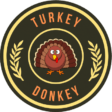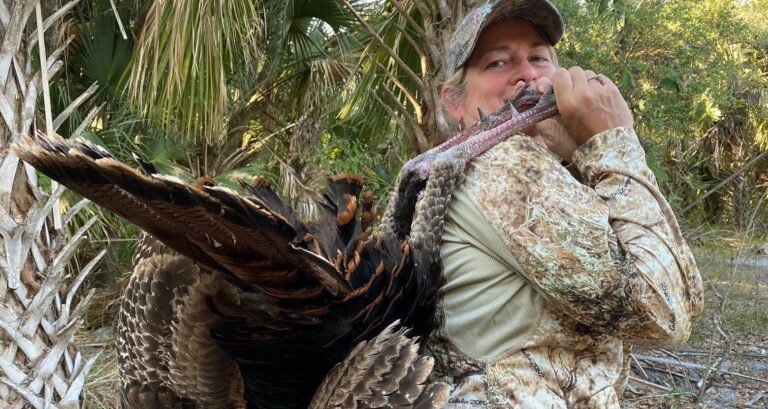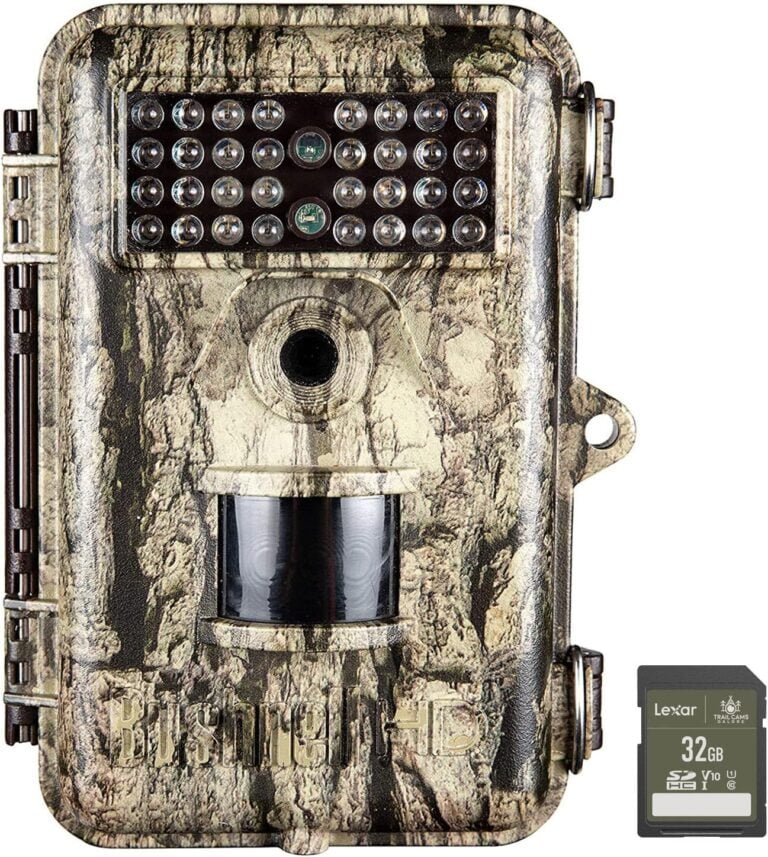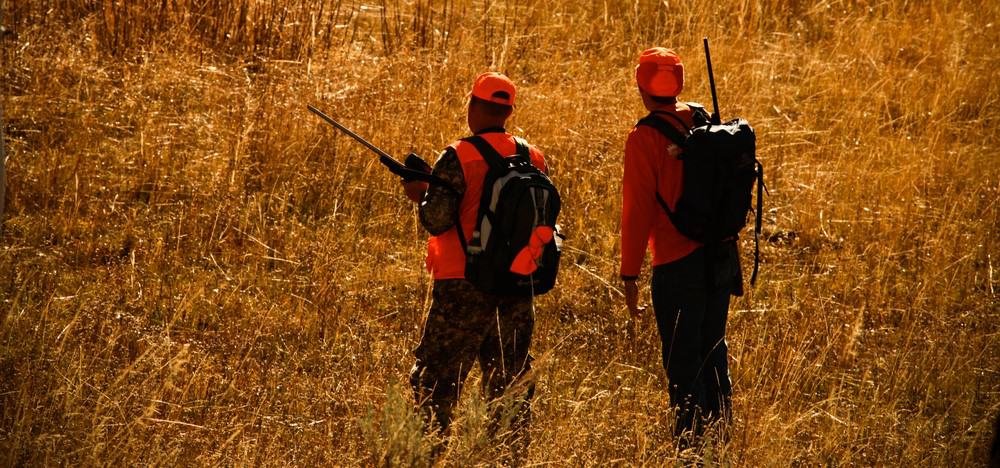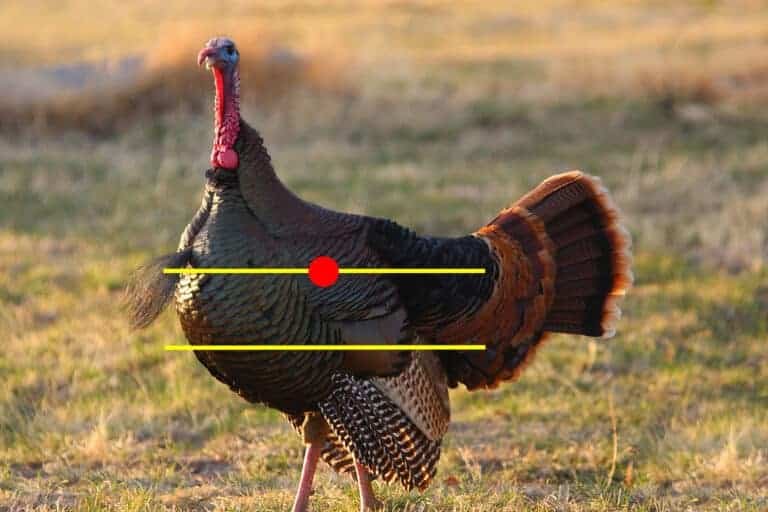The Best Turkey Hunting Gear for 2024
Picture this: It’s a chilly spring morning, and you’re tucked against an old oak tree. The woods are waking up, and suddenly, you hear a distant gobble that angers your heart. Are you ready for that moment? Let’s ensure you have the best turkey hunting gear for 2024.

Hey there, fellow turkey hunters! I’m Jimmy, and I’ve been chasing gobblers for over 20 years. Let me tell you, having the right gear can make or break your hunt. But here’s the thing – you don’t need to break the bank to bag a bird.
In this, we are willing to talk about the best turkey gear to help you bring home a tom. I’m not just going to manych of expensive stuff you don’t need. Nope, we’re talking about the gear that renters – the stuff that’ll keep you hidden, comfortable, and ready when that big boy struts into view.
Clothing and Camouflage: Blend In to Win
Listen up, folks – if there’s one thing I’ve learned in all my years of turkey hunting, it’s that these birds have eyes like hawks. If you stick out like a sore thumb, you might as well stay home. But don’t worry; I’ve covered you with some tried-and-true tips on what camo clothing to wear in the turkey woods.
Here’s how to prepare for anything with the right turkey hunting clothes.
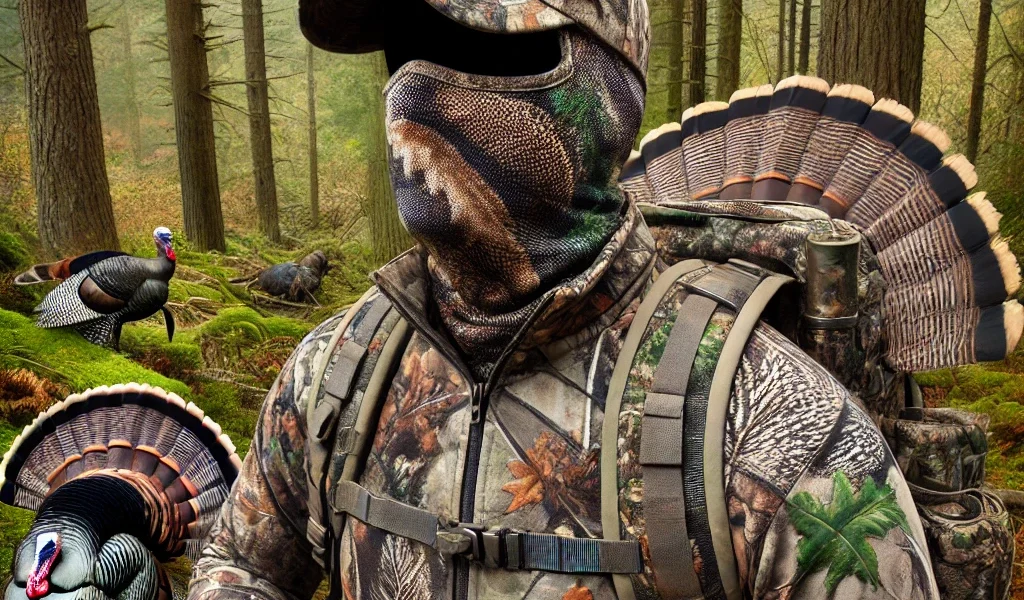
Camouflage Patterns: Become One with the Woods
Match Your Surroundings:
Early season? Go for patterns with lots of brown and gray.
Later in spring? Look for a turkey camo with more green.
Pro tip: Take a walk in your hunting spot before the season. Notice the colors and patterns around you.
Break Up Your Outline:
Turkeys are great at spotting human shapes.
Choose patterns with irregular shapes and shadows.
Brands like Mossy Oak and Realtree make some great options.
Don’t Forget Your Face and Hands:
A camo face mask or face paint is a must.
Gloves not only hide your hands but keep them warm on chilly mornings.
Layering: Be Ready for Any Weather
Turkey season can be tricky – one day, it’s freezing, and the next, it’s sweltering. Here’s how to be ready for anything:
Base Layer:
Start with moisture-wicking materials like merino wool or synthetic fabrics.
Avoid cotton – it gets cold when wet and stays that way.
Insulating Layer:
Fleece or lightweight down for those frosty mornings.
Make sure it’s not too bulky – you need to be able to move quietly.
Outer Layer:
Go for something quiet and water-resistant.
Look for jackets and pants with pockets for calls, shells, and snacks.
Turkey Hunting Vests: Your Mobile Command Center
A good turkey vest, like the Equinox turkey vest, is worth its weight in gold. Here’s what to look for:
Comfort:
Padded back and shoulders for those long sits.
Adjustable straps for a perfect fit.
Storage:
There are plenty of pockets for calls, shells, and other gear.
Some vests come with a built-in seat cushion – your backside will thank you!
The Equinox turkey vest also features a water bladder system and rapid deployment functionality, making it a premium option for high performance.
Game Bag:
There is a large pocket in the back for carrying out your turkey.
Make sure it’s easy to clean – things can get messy!
Remember, the best camo in the world won’t help if you’re fidgeting because you’re uncomfortable. Invest in quality gear that fits well and suits your hunting style. It might cost a bit more upfront, but you’ll be glad you did when sitting still for hours waiting for that gobbler to come in.
Next, we’ll talk about the business end of turkey hunting – firearms and ammo. But for now, dress smart, stay comfortable, and become a part of the woods. Do that, and you’re already halfway to bagging your bird!
Firearms and Ammunition: The Tools of the Trade

Alright, turkey hunters, let’s talk about the business end of our sport – the shotguns and shells that’ll help you put that gobbler on the ground. I know some folks can get pretty heated about the “best” gun or load, but here’s the truth: the best setup is the one you’re comfortable with and can shoot well. That said, let’s break down some options.
Shotguns: Your Turkey-Thumping Tool
- Gauge Options:
- 12 gauge: The old standby. Plenty of power and lots of ammo choices.
- 20 gauge: Lighter recoil, but still gets the job done. Great for smaller-framed hunters or those who don’t like the kick of a 12 gauge.
- .410 bore: The new kid on the block. With today’s specialized turkey loads, it’s become a viable option.
Pro tip: Whatever gauge you choose, practice with it! A 12 gauge you can’t shoot well is no match for a 20 gauge you’re comfortable with.
- Barrel Length and Choke Considerations:
- Barrel length: 21-26 inches is the sweet spot for maneuverability in the woods.
- Chokes: Your best bet is extra-full or specialized turkey chokes. They keep your pattern tight at longer ranges.
Remember: Pattern your gun before the season. Every shotgun is different, and knowing your effective range is crucial.
Ammunition: The Right Load for the Job
Choosing the right ammo is just as important as picking the right gun. Here’s what to look for:
- Shot Sizes:
- #4, #5, and #6 are all popular choices.
- A heavier shot (like #4) carries more energy but fewer pellets.
- A lighter shot (like #6) gives you more pellets but less knockdown power at a distance.
- My go-to? A duplex load with a mix of #5 and #6. It’s the best of both worlds!
- Non-toxic Options:
- Some areas require non-toxic shot. Check your local regulations!
- Tungsten loads are pricey but super effective.
- Steel works, but you might need to choose a larger shot size for the same effectiveness as a lead.
- Specialized Turkey Loads:
- Brands like Winchester Long Beard XR or Federal TSS offer extended range and hard-hitting performance.
- They cost more than standard loads, but the performance can be worth it.
Here’s a little secret: The fanciest, most expensive ammo in the world won’t make up for poor shooting. Spend time at the range, learn your gun’s pattern, and practice turkey calling. That’s the real recipe for success.
Remember, safety comes first! Always treat your firearm respectfully, know your target and what’s beyond it, and follow all local hunting regulations.
Next, we’ll dive into the world of turkey calls and decoys – the tools that’ll bring that big tom into your lap. But for now, remember: choose a shotgun that fits you well, pair it with the right ammo, and practice, practice, practice!
Calls and Decoys: Speaking Turkey and Setting the Scene
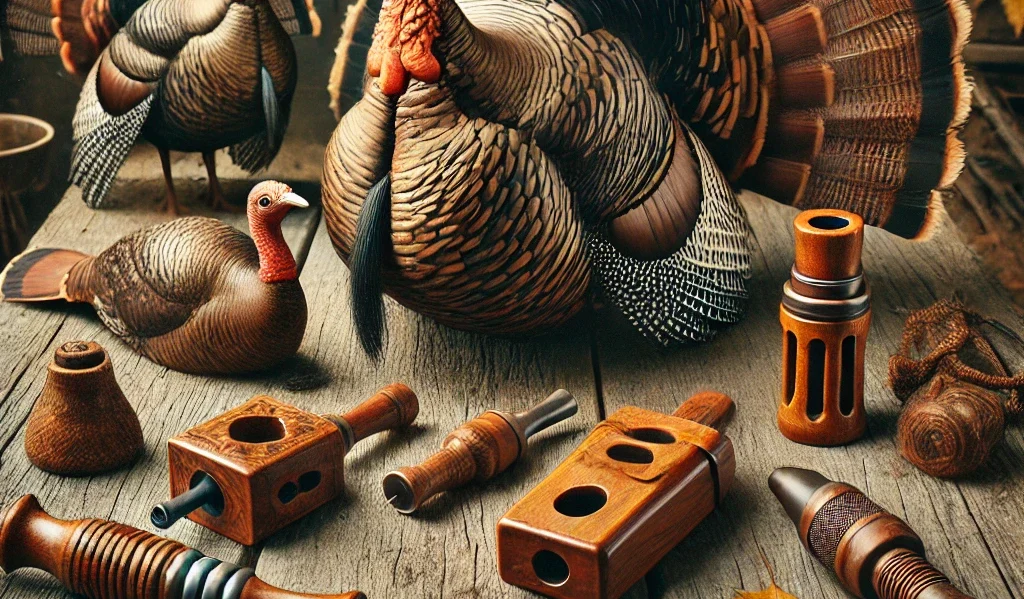
Alright, turkey hunters, now we’re getting to the fun part – the gear that lets you talk business and set up a scene so irresistible that ol’ Tom can’t stay away. Let’s break down the calls and decoys with those gobblers coming in on a string.
Types of Turkey Calls: Making Sweet Turkey Music
- Box Calls:
- Great for beginners and pros alike.
- Loud and versatile – can make yelps, clucks, and purrs.
- Pro tip: Chalk your box call lid regularly for the best sound.
- My favorite? The Lynch Fool Proof Box. It’s easy to use and sounds great.
- Slate Calls (aka Pot Calls):
- Offer a wide range of sounds.
- It takes some practice, but it’s very realistic once you get the hang of it.
- Use different strikers (wood, carbon, plastic) for different sounds.
- Keep your slate dry and clean for the best performance.
- Diaphragm Calls (Mouth Calls):
- Hands-free operation – great when you’re all set up and ready to shoot.
- Takes the most practice but offers the most versatility.
- Come in different cuts (2-reed, 3-reed, etc.) for different sounds.
- Start with a double-reed call if you’re new to mouth calls.
Remember, you don’t need to master every type of call. Find one or two that work for you, and practice until you can make them sing!
Decoys: Setting the Stage for Success
Decoys can be a game-changer, especially in open areas where turkeys can see a long way. Here’s what you need to know:
- Hen Decoys:
- The bread and butter of turkey decoys.
- Use in feeding or ready-to-breed poses.
- Brands like Avian-X and Dave Smith Decoys make some ultra-realistic options.
- Jake Decoys:
- It can make dominant toms jealous and come in to fight.
- Use cautiously – they can also scare off less dominant birds.
- A Jake and hen combo can be deadly effective.
- Full-Strut Decoys:
- The big guns of turkey decoying.
- It can fire up a dominant tom.
- Be careful – other hunters might mistake it for a real bird. Always prioritize safety!
- Decoy Setup Tips:
- Less is often more. A single hen or a hen and Jake is usually plenty.
- Place decoys in open areas where they’re visible from a distance.
- Set them up about 20 yards from your position – close enough for a shot, far enough to keep incoming birds focused on the decoys.
Here’s a pro tip: Learn to read the turkeys. Don’t be afraid to switch things up if they’re not responding to your calls or decoys. Sometimes, a soft cluck works better than an aggressive yelp, or a single hen decoy outperforms a whole flock setup.
Remember, calls and decoys are tools to bring turkeys into range. They’re not magic wands. Use them with good woodsmanship, patience, and smart hunting tactics.
Next, we’ll talk about the optics that’ll help you spot those turkeys before they spot you. But practice those calls now and think about how you’ll set up your decoys. Get these right, and you’re on your way to a successful hunt!
Optics: See the Unseen
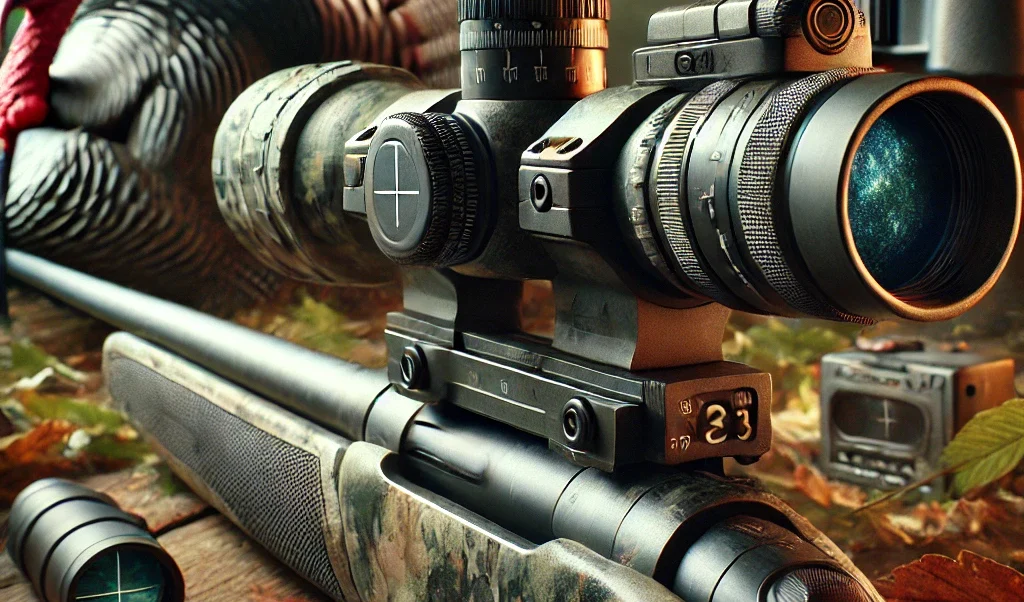
Alright, turkey hunters, let’s talk about boosting your eyes in the field. Good optics can distinguish between bagging a bird and going home empty-handed. They help you spot turkeys at a distance, judge that tom’s beard length, and even stay safe by identifying what’s beyond your target.
Let’s break down the two main types of optics you’ll want to consider.
Binoculars: Your Long-Distance Eyes
- Choosing the Right Pair:
- Look for 8×42 or 10×42 binoculars. The first number is magnification; the second is lens diameter.
- 8×42 gives you a wider field of view and a steadier image.
- 10×42 offers more magnification but can be harder to hold.
- Features to Consider:
- Waterproof and fogproof: Turkey hunting often means damp mornings.
- Rubber armor: Protects against bumps and provides a non-slip grip.
- Quality glass: Brands like Vortex, Leupold, or Nikon offer good options at various price points.
- How to Use Them:
- Glass fields and forest edges at first light to locate birds.
- Use them to spot turkeys strutting in fields from a distance.
- Check out potential roost trees in the evening.
Pro tip: Practice using your binos before the season. Get used to bringing them up to your eyes quickly and smoothly.
Range Finders: Know Your Distance
- Why Use a Range Finder:
- It helps you know exactly how far away that turkey is.
- It’s crucial for ethical shots, especially if you’re pushing the limits of your effective range.
- It can help you set up decoys at the perfect distance.
- Features to Look For:
- Compact and lightweight: You don’t need huge magnification for turkey hunting.
- Quick to use: Look for models with one-button operation.
- Angle compensation: Helpful if you’re hunting in hilly terrain.
- Top Picks:
- Bushnell Bone Collector: Affordable and reliable.
- Vortex Impact: Great mid-range option with angle compensation.
- Leupold RX-FullDraw 5: High-end choice with specialized archery features (great if you bow hunt too).
- Using Your Range Finder:
- Range landmarks around your setup before the hunt starts.
- Use it to check the distance to your decoys.
- Always range a turkey before taking the shot, if possible.
Remember, the best optics in the world won’t help if you don’t use them. Make a habit of glassing regularly, especially during those first and last hours of daylight when turkeys are most active.
Here’s a little secret: Good optics can save you a ton of walking. Instead of hiking all over creation, find a good vantage point and let your binoculars do the work. You’ll spot more turkeys and save energy for when it counts.
Next, we’ll discuss keeping comfortable in the woods with blinds and seating. But for now, remember that in turkey hunting, the eyes often have it. Invest in good optics and learn to use them well, and you’ll be spotting gobblers that other hunters miss!
Blinds and Seating: Comfort Meets Concealment
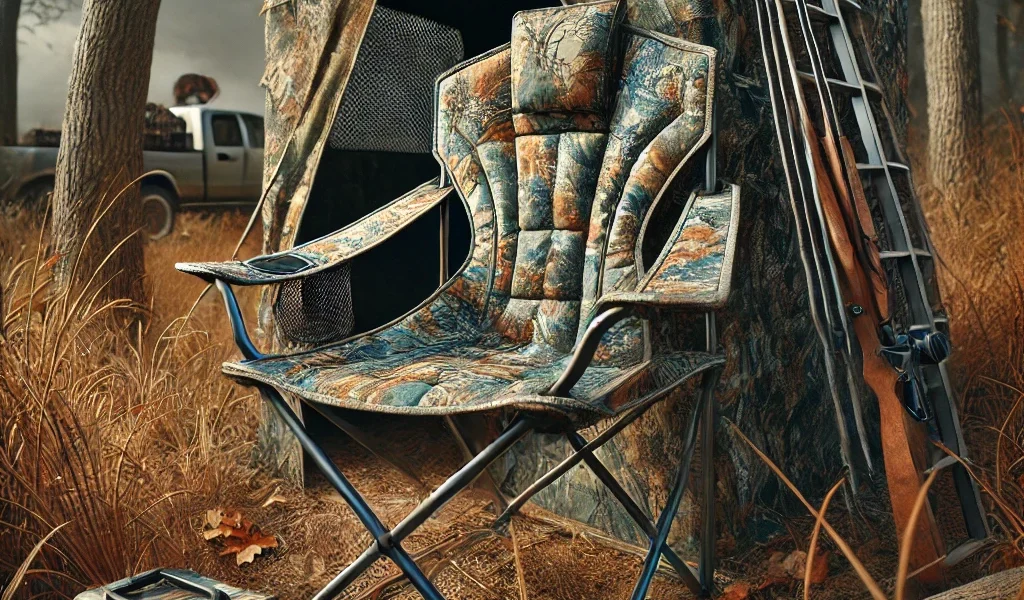
Alright, turkey hunters, let’s talk about staying hidden and comfortable in the woods. A good setup can mean the difference between fidgeting and spooking birds, or sitting still for hours and bagging that big tom. We’ll cover both blinds and seating options to keep you in the game all day long.
Pop-up Blinds: Your Mobile Hunting Lodge
- Advantages of Pop-up Blinds:
- Great concealment, especially in open areas.
- Allows for more movement without spooking birds.
- Keeps you dry in wet weather.
- Good option if hunting with kids or camera.
- Choosing the Right Blind:
- Look for easy setup and takedown. Practice at home!
- Consider size: bigger isn’t always better. A 2-3 person blind is usually plenty.
- Check the window configuration. More options = more shooting opportunities.
- Durability matters. Brands like Primos Double Bull or Rhino Blinds are solid choices.
- Using Your Blind Effectively:
- Set up well before daylight or the day before your hunt.
- Brush it in with natural vegetation for better concealment.
- Keep it dark inside. Wear dark clothes and cover shiny objects.
Pro tip: If you’re hunting private land, consider leaving your blinds up all season. Turkeys will get used to it, making it even more effective.
Natural Blinds: Blending with Mother Nature
- Advantages of Natural Blinds:
- Lightweight and mobile. Great for run-and-gun hunting.
- Can be adapted to any terrain or cover.
- Often more effective than artificial blinds in heavily pressured areas.
- Creating an Effective Natural Blind:
- Use existing features: trees, brush piles, fallen logs.
- Bring along a pruning saw or clippers to enhance natural cover.
- Consider portable options like the Ghostblind or HECS Stealthscreen.
- Tips for Natural Concealment:
- Break up your outline. Avoid “blobbing” against a tree.
- Stay in the shadows, especially early and late in the day.
- Be mindful of your backdrop. Don’t skyline yourself on ridges.
Comfortable Seating: Because Patience is Key
- Turkey Vest with Seat:
- Built-in comfort. Brands like ALPS OutdoorZ or Tenzing are popular.
- Always with you, great for run-and-gun style hunting.
- Look for good back support and adjustable legs.
- Portable Seats:
- Lightweight options like the Hunt Comfort Gel Core or Therm-a-Seat.
- More comfortable than sitting directly on the ground.
- Easy to carry and quick to deploy.
- Blind Chairs:
- If using a pop-up blind, consider a low-profile chair.
- Look for quiet materials and a swivel base for easy repositioning.
- The Alps OutdoorZ Stealth Hunter or Millennium G100 are solid choices.
Remember, comfort equals patience, and patience kills turkeys. Don’t skimp on your seating setup.
Here’s a secret from an old turkey hunter: The most comfortable setup is the one that lets you sit dead still the longest. Experiment with different options and find what works best for you.
Next up, we’ll cover those extra accessories that can make or break your hunt. But for now, think about how you’ll stay hidden and comfortable this season. Get these basics right, and you’ll be ready to outwait even the wariest old gobbler!
Accessories: The Little Things That Make a Big Difference
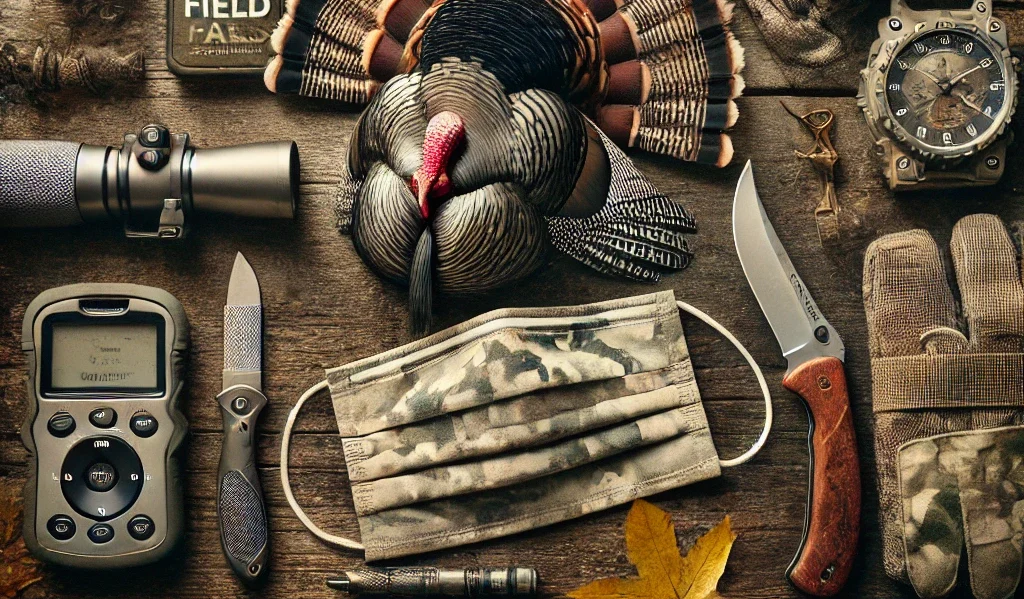
Alright, turkey hunters, we’ve covered the big stuff, but now let’s talk about those extra items that can turn a good hunt into a great one. These accessories might seem small, but trust me, they can make a difference when you’re out in the woods.
Game Bags: For When Your Hunt is Successful
- Why You Need One:
- Keeps your turkey clean during transport.
- It makes carrying your bird out of the woods easier.
- Some states require them for proper tagging.
- Choosing a Game Bag:
- Look for breathable, mesh materials.
- Consider size – it should fit a large tom with room to spare.
- Durability matters – a reinforced bottom is a plus.
- Top Picks:
- Alps OutdoorZ Turkey Tote: Affordable and gets the job done.
- Hunters Specialties Deluxe Turkey Tote: Extra pockets for gear.
Pro tip: Keep your game bag in your vest or blind. You’ll be glad it’s right there when you bag a bird.
Pruning Shears: Your On-the-Spot Blind Builder
- Uses in the Field:
- Clear shooting lanes quietly.
- Improve your natural blind setup.
- Cut leafy branches to add to your pop-up blind.
- What to Look For:
- Compact size for easy carrying.
- Sharp blades for quick, quiet cuts.
- Non-reflective finish to avoid spooking game.
- Recommended Options:
- Fiskars PowerGear2 Pruner: Compact and powerful.
- Corona ClassicCUT Forged Bypass Pruner: Durable and reliable.
Remember: Always get landowner permission before cutting live vegetation.
Compass or GPS: Because Getting Lost Isn’t Fun
- Why Navigation Tools Matter:
- Find your way in unfamiliar territory.
- Mark your vehicle location for easy return.
- Locate property boundaries in new hunting areas.
- Choosing Between Compass and GPS:
- Compass: Never needs batteries, always reliable. Learn to use one!
- GPS: More features, can mark waypoints, but needs power.
- Top Picks:
Pro tip: Even if you use a GPS, always carry a backup compass and know how to use it.
First Aid Kit: Safety First, Always
- Essential Items to Include:
- Band-aids and gauze
- Antiseptic wipes
- Tweezers (great for ticks)
- Any personal medications you might need
- Choosing a Kit:
- Look for compact, waterproof options.
- Consider kits designed for outdoor use.
- Recommended Kits:
Remember, the best first aid kit is the one you have with you. Keep it in your vest or blind bag at all times.
Here’s a little secret from years in the woods: These small items can save your hunt. I can’t count the times a pair of pruning shears or a well-stocked first aid kit has made the difference between going home early and bagging a bird.
Next up, we’ll cover some important safety equipment. But for now, consider these accessories and how they fit into your hunting setup. Being prepared with these little extras can make your time in the turkey woods more enjoyable and successful!
Safety Equipment: Because Coming Home is Important
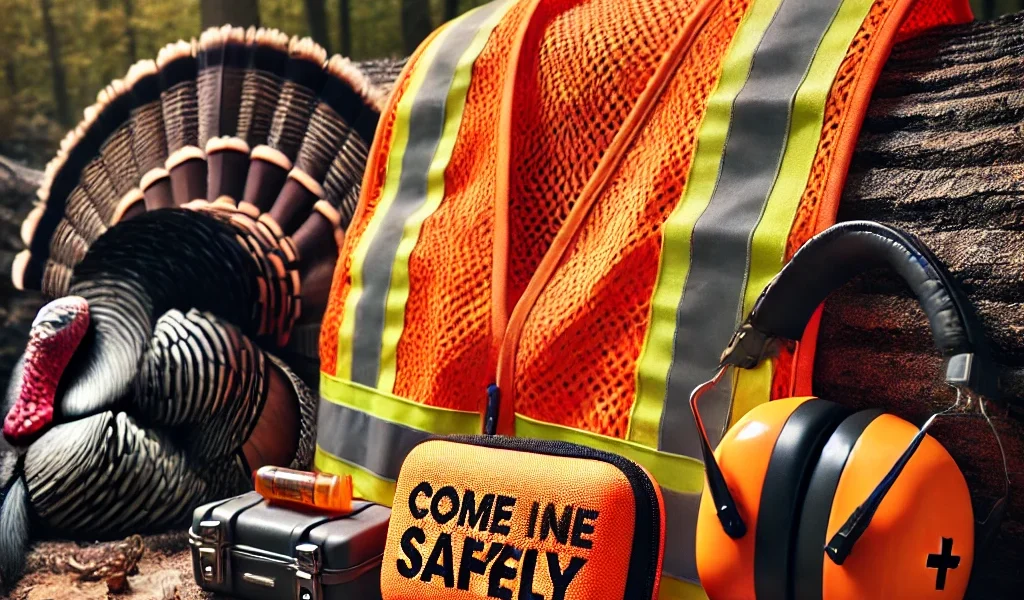
Alright, turkey hunters, we’ve covered a lot of gear that’ll help you bag a bird, but now let’s talk about the most important equipment of all – the stuff that keeps you safe out there. Remember, no turkey is worth risking your health or life for.
Blaze Orange for Walking In/Out
- Why It’s Critical:
- It makes you visible to other hunters.
- It is required by law in many states during certain seasons.
- It doesn’t spook turkeys (they can’t see orange like we do).
- What to Wear:
- Blaze orange vest or jacket for walking in and out.
- Hat or cap for additional visibility.
- Top Picks:
- Allen Company Blaze Orange Safety Vest: Lightweight and affordable.
- Browning Safety Blaze Vest: Durable with added pockets.
Pro tip: Keep your blaze orange easily accessible. Put it on before moving, even if you’re just repositioning during your hunt.
Bug Spray and Tick Prevention
- Importance of Insect Protection:
- Prevents distracting (and potentially dangerous) bug bites.
- Reduces the risk of tick-borne diseases like Lyme disease.
- Choosing the Right Products:
- Look for sprays with DEET or Picaridin for mosquitoes.
- Permethrin-treated clothing for long-lasting tick protection.
- Recommended Options:
- Additional Tick Prevention Tips:
- Wear long sleeves and pants, tucking pants into socks.
- Conduct thorough tick checks after each hunt.
- Consider using tick removal tools like the Tick Key.
Eye and Ear Protection
- Why It Matters:
- Protects your vision from brush and debris.
- It prevents hearing damage from shotgun blasts.
- Choosing Eye Protection:
- Look for shatterproof lenses.
- Consider light-enhancing amber or yellow tints for low-light conditions.
- Ear Protection Options:
- Passive earplugs: They are cheap, effective, and always work.
- Electronic earmuffs: Allow normal hearing but block loud noises.
- Top Picks:
- Eye Protection: Wiley X Saint
- Ear Protection: Walker’s Razor Slim Electronic Muffs
Remember, you only get one set of eyes and ears. Protect them!
Emergency Communication
- Why It’s Essential:
- It allows you to call for help in case of an emergency.
- Provides peace of mind for you and your loved ones.
- Options to Consider:
- Fully charged cell phone (but don’t rely solely on this).
- Two-way radios for communicating with hunting partners.
- Personal locator beacon (PLB) for remote areas without cell service.
- Recommended Gear:
Here’s a secret from an old turkey hunter: The most successful hunters I know are also the safest. They come prepared, they stay alert, and they never take unnecessary risks.
Remember, all the fancy gear in the world won’t help if you’re not being safe out there. Prioritize your safety equipment, use it properly, and make sure you come home to hunt another day!
Conclusion

This guide to the best turkey hunting gear covers a lot of ground. From essential clothing and firearms to calls, decoys, and safety equipment, you’re now armed with the knowledge to gear up for a successful and safe turkey hunting season.
Remember, the best gear is the gear that works for you. Don’t be afraid to experiment and find your personal preferences. And always prioritize safety above all else.
Get out there, put this gear to good use, and enjoy the thrill of the turkey woods. Good luck, and happy hunting!
Additional Resources
For more information on turkey hunting gear, regulations, and techniques, check out these helpful resources:
- National Wild Turkey Federation (NWTF)
- Your state’s wildlife agency website for local regulations and season dates
- Online forums for gear reviews and hunter experiences
- Local hunting supply stores for hands-on experience with gear
Remember to always check and follow your local hunting regulations before heading out. Good luck, and may your season be filled with gobbles!
